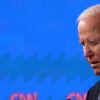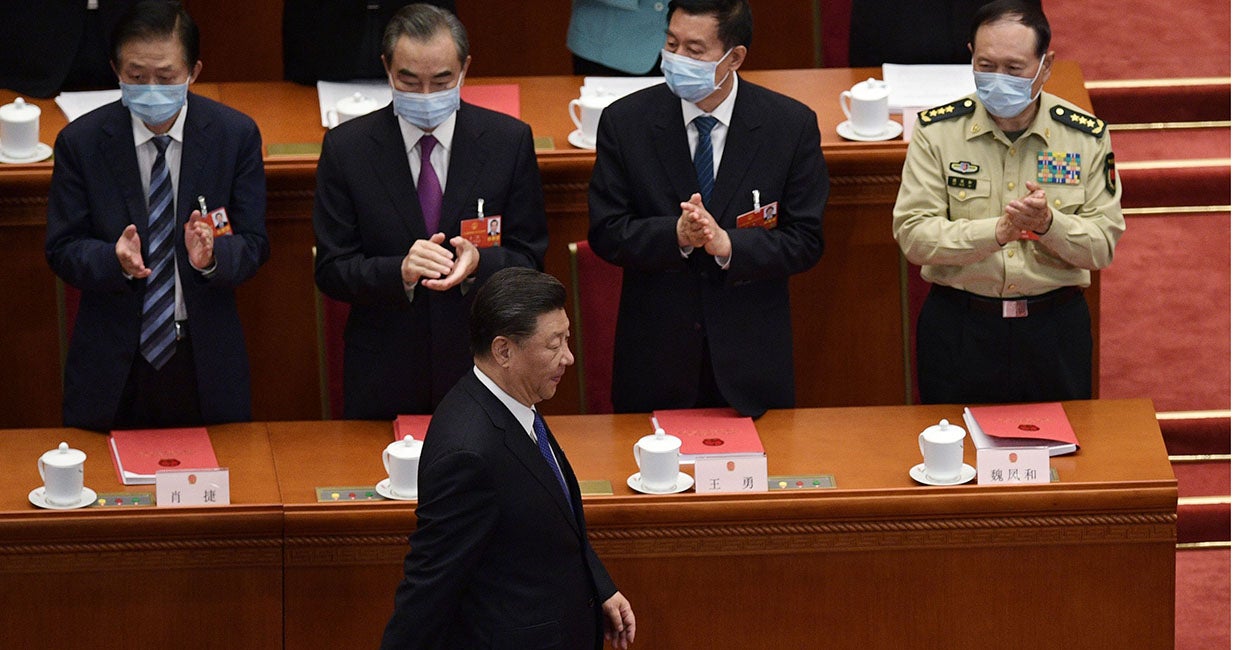This article is an excerpt from the “2020 Mandate for Leadership: A Clear Vision for the Next Administration.” It looks back at policy decisions made by the Trump administration over the past four years. You can purchase your copy of “Mandate 2020” here.
In some ways, it was inevitable that China would be a challenge for American security planners. With a population of 1.3 billion, it has the human resources to field large militaries and simultaneously staff factories and undertake research.
Like the United States, China is a continent-size country with substantial resources. Equally as important, its economy has grown steadily and is now second only to that of the United States.
The Daily Signal depends on the support of readers like you. Donate now

However, it is not only the growth of the Chinese economy that has led to increased tensions between Beijing and Washington. Increasingly, China has challenged the international rules-based order with regard to the sea lanes along the Pacific littoral, waters that carry over half of the world’s trade. It has long threatened Taiwan, a democratic enclave, arguing that it has the right to use any means necessary, including force, to compel the return of the “renegade province.”
Historical and territorial as well as political considerations also set China at odds with key U.S. allies in the region, including Japan and the Philippines.
The challenge that the People’s Republic of China poses to American security planners is very different from challenges presented a hundred years ago or by the Soviet Union in the middle of the 20th century. China comes from a very different historical and cultural tradition and therefore has a very different outlook.
China, throughout its millennia-long history, has never confronted a balance of power. Instead, it has long been the dominant power on mainland Asia, surrounded by tributary rather than balancing states. From China’s perspective, this is its rightful place.
China is also different in that the Chinese Communist Party is less ideological than its Soviet counterpart in its foreign policy dealings. It no longer strives to replicate the Chinese Communist Party model beyond its borders as it did under Mao Zedong.
Beijing is willing to work with a variety of partners, from Western European social democracies to strongman authoritarians such as Kim Jong Un and Robert Mugabe, as long as it serves Chinese economic and political interests. It does not care about the ideological coloration of its partners.
This makes the People’s Republic of China much more flexible in its diplomatic outreach.
Where Beijing draws the line is on perceived threats to the Chinese Communist Party’s hold on power, whether foreign or domestic. Deng Xiaoping, despite his willingness to open China to the West, warned regularly about “westernization” (pluralist politics in China). His successors condemned “peaceful evolution,” another proxy for democratization.
Any kind of political change that would challenge the Chinese Communist Party’s grip on power is seen as an existential threat. The West, with its democratic principles and concern for human rights, is seen as undermining the legitimacy of the Chinese Communist Party.
The combination of these elements has led China to take a more holistic view of its security situation. For the Chinese leadership, the key concept is “comprehensive national power,” whereby national capability is comprised of a number of components, including military power, economic capability, diplomatic respect, political unity, and even cultural security.
By this logic, to be secure, a nation needs to build its comprehensive national power by strengthening each aspect. Neglect of any one, like overconcentration on any one, can undermine overall national security.
Further complicating things, power today is far more diffuse within the international system. The democratization of information and the globalization of supply chains make all countries more vested players in the international system, as well as major markets and key influencers.
As Singapore and Hong Kong demonstrate, it is no longer just physical space or size of the military that matters in international conversations. To deal with this new context, China seeks not only to influence other states directly through its power, but also to challenge indirectly the American-led vision of human rights, international norms, and global industrial standards.
Given this wide-ranging perspective, the Chinese Communist Party is prepared to undertake a broader, more extended approach toward its national security.
It employs multiple tools, from economic investment to public diplomacy to military coercion, working with a variety of other states to achieve Chinese goals. Importantly, China’s economic strength affords the Chinese Communist Party more resources and allows it to sustain its efforts for a more prolonged period.
Consequently, the People’s Republic of China poses the most comprehensive, complex challenge to American interests since at least the Cold War, one that extends beyond the military realm to include economic, financial, diplomatic, and strategic messaging and public diplomacy strands.
These efforts are focused, first and foremost, on fulfilling what Chinese President Xi Jinping has termed the “China dream of the great rejuvenation of the Chinese nation.”
This entails elevating the People’s Republic of China to the front ranks of global powers by 2049, the hundredth anniversary of the founding of the People’s Republic of China. This includes making China largely autonomous in key industrial areas and raising its gross domestic product per capita, which is currently about $8,800, behind Mexico and Malaysia.
Given the emphasis on “comprehensive national power,” the China dream will also certainly include improvements in the various other elements, including political unity (for example, reunifying with Taiwan), and improvements in Chinese science and technology.
In this context, it is important to note that one of the elements of the “China dream” is a strong Chinese military. As a result, the Chinese People’s Liberation Army is a growing challenge to the United States.
Unlike the Soviet military, which fielded a global military and substantial power projection capabilities, the People’s Liberation Army is still largely focused on contingencies closer to the People’s Republic of China, but the establishment of Chinese overseas bases and access, coupled with its growing fleet and naval infantry forces, clearly indicates that the People’s Liberation Army in the future will be capable of sustained operations far from the Chinese homeland.
Unlike the Soviet Union, however, the Chinese are not focused solely or primarily on the military component of international competition. The People’s Liberation Army is only part of the overall threat posed by the People’s Republic of China; economic and political development are still higher priorities.
From the Chinese Communist Party perspective, China is enjoying a “moment of strategic opportunity.” With a low potential for major war, the People’s Republic of China has an opportunity to catch up with the West by improving its comprehensive national power, and this includes strengthening its diplomatic ties as well as improving its economic and technological capabilities.
The Belt and Road Initiative is an excellent example of how Beijing weaves economic, political/diplomatic, and technological elements together to achieve its strategic aims.
Beyond the direct commercial advantages it offers, the initiative will help China to build friendly links, set industrial standards, and potentially provide access to information and infrastructure networks as it helps to construct them and will thus create new inroads for Chinese political and diplomatic influence in Central Asia, South Asia, Africa, and Europe.
These efforts are facilitated by the reality that China is not a market economy: Many of them are undertaken by state-owned enterprises that are insulated from the full impact of their business decisions.
The Chinese Communist Party hopes that economic investments of this sort will generate not only economic, but also strategic political, and perhaps even military benefits. China’s military capabilities are, for now, mainly in the background, providing a supporting rather than starring role.
Similarly, China is striving to influence global opinion through its own form of political warfare. This includes measures of “public opinion warfare” such as the Confucius Institutes.
Begun as a laudable effort to teach foreigners the Chinese language, these institutes have since reportedly sought to channel and direct “acceptable” avenues of academic inquiry and topics of research consistent with Chinese interests.
America’s current approach to the growing challenge from China has had mixed success. The brightest spot has been in the security realm.
In a marked improvement from the previous administration’s approach, Washington has shifted from a largely passive stance toward one that more directly counters China’s efforts to establish itself as the premier power in the western Pacific.
Where the U.S. seemingly acceded to extravagant Chinese claims in the South China Sea by, for example, not challenging Chinese island building for three years and seemed to welcome a larger Chinese role by inviting China to participate in the American-led biennial Rim of the Pacific exercises, it now is conducting freedom of navigation operations on roughly a bimonthly basis around those artificial islands, rescinded its invitation to the 2018 Rim of the Pacific, and has repeatedly conducted naval passages through the Taiwan Strait in support of Taiwan and freedom of the seas.
Generally, advances in U.S.-Taiwan relations like the Taiwan Travel Act, the TAIPEI Act, and the 2019 meeting between the two governments’ national security advisers have set a new diplomatic precedent in favor of engagement. In 2020, Secretary of Health and Human Services Alex Azar became the first Cabinet secretary since 2014 to visit Taiwan.
These moves not only underscore the continuing importance of Taiwan in the American conception of western Pacific security, but also make clear that American policy toward the region would be set in Washington, not Beijing.
A consistent schedule of arms sales to Taiwan, including the new F-16 fighters the Trump administration made good on, further reinforce this message.
More broadly, the U.S. is encouraging a growing regional and global awareness that the People’s Republic of China poses a major challenge to the international rules-based order.
Japan has clearly chosen to align its defense and foreign policy more closely with the United States, increasing Japanese defense and collaborating with American efforts to secure key domains such as outer space and cyberspace.
This follows the unprecedented American commitment that a cyberattack against Japan “could, in certain circumstances, constitute an armed attack under Article 5 of the U.S.–Japan Security Treaty.”
Similarly, key allies like Japan, Australia, the U.K., and France have now joined the U.S. in limiting the incorporation of Huawei information and communications technology products into their domestic networks.
Questions about the security of information moving over Chinese-manufactured hardware have gained prominence even as the Trump administration has also focused more attention on Chinese cyber economic espionage, including various hacking incidents.
This latter aspect has led to perhaps the most controversial part of the U.S.-China relationship of the past four years. The Trump administration has chosen to employ a variety of tariffs and economic sanctions ostensibly to punish China’s lack of respect for intellectual property rights, its noncommercial practices, and its continued use of subsidies and other measures that contradict its commitments under the World Trade Organization.
Efforts by the administration have highlighted the asymmetry in the American and Chinese treatment of foreign investment and trade, even as they resulted in higher costs for American importers and retaliation against American farmers.
The long-term impact on the U.S. economy of cutting off Chinese information and communications technology manufacturers ZTE and Huawei from large swaths of the American market is difficult to predict. In the near-term, however, it has demonstrated that supply chain dependencies are not one-way, with China holding the whip hand.
Because China’s economic model continues to emphasize the role of the state in its development, as well as direct ties between business and the military, there are also concerns about economic engagement abroad.
Chinese investments in key technologies are often seen as supporting not only China’s economy, but also its intelligence services and long-term military interests; similarly, access to personally identifiable information about American individuals may have security as well as commercial implications.
These concerns, exacerbated by explicit Chinese emphasis on civil-military fusion, have led Congress to reassess how the U.S. reviews foreign investment and export controls within the context of national security. In 2018, it passed landmark legislation to comprehensively address both—the Foreign Investment Risk Review Modernization Act and the Export Control Reform Act.






























